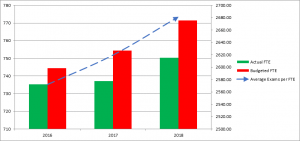DHB Employed MIT Strike: “We Simply Can’t Cope Anymore”
Nearly 1100 DHB-employed Medical Imaging Technologists (MITs) across New Zealand are set to strike for 24 hours commencing at 0700 hours on Monday 30th September and are voting on a proposed second 24-hour strike on Wednesday 2nd October, after nine months of employment agreement negotiations have failed to secure a settlement.
MITs are essential to radiology services, assisting with the diagnosis and treatment of patients using general X-rays, CT, MRI, mammography, angiography and nuclear medicine. Around 80% of all hospital patients will be imaged by an MIT during their diagnosis and treatment.
But relentless growth in demand for radiology services has outstripped the capacity of the existing DHB MIT workforce to deliver them, resulting in serious recruitment and retention issues in multiple areas. The graph below demonstrates the problem.
The “Budgeted FTE” is the amount of money the DHBs have set aside to employ staff; the “Actual FTE” is the number of staff the DHBs actually employ. In the case of MITs, the number of staff the DHBs want and need to employ (budgeted FTE) outstrips the actual number employed which leaves existing MITs under considerable pressure to increase the number of examinations (X-rays, CTs etc) they each do.
“This workforce crisis has gotten to a point where the MITs simply can’t cope anymore.” says Dr Deborah Powell, National Secretary of APEX, the MITs union.
“We can all work at above 100% efficiency for a time and when the need arises, but we simply can’t work at that pace all the time which is what is now being demanded of the MITs.”
Vacancy rates are as high as 25%-30% in some areas.
Negotiations for the MITs’ national MECA (Multi Employer Collective Agreement) covering all 20 DHBs started in December 2018.
“Initially the bargaining was constructive, with both parties recognising the need for the negotiations to address mutually agreed key issues”, says Dr Powell.
“We set out to do this in a way that recognised and rewarded MITs for developing the skills and flexibility needed within this essential workforce.”
“Excellent progress was made towards reaching a settlement until, in June, the DHBs performed an abrupt U-turn and took all the agreements they had made in bargaining up to that point off the table and basically started the bargaining again from scratch. Unfortunately, negotiations have not gone well since then.”
The MITs then received an offer from the DHBs in late August after the DHBs were notified of potential strike action earlier this month. However, that offer has been rejected:
“While the offer contains the same pay rises which other health practitioners have recently been offered – essentially 3% per annum over 3 years – the offer put to the MITs also contains a clawback that would see MITs starting work in the more specialised areas of CT and Angiography being paid 12% less a year for their first 6 years.”
“This amounts to a $43,000 pay cut over 6 years and will exacerbate the already pressing issues we have in attracting MITs to work in these areas.” say Dr Powell.
“The offer also fails to address the particularly severe workforce shortages amongst those MITs with additional postgraduate qualifications in mammography, MRI and nuclear medicine.”
Strike action is now pending to achieve a settlement.
ENDS
Learn more about our Medical Imaging Technologists (MIT) division.

